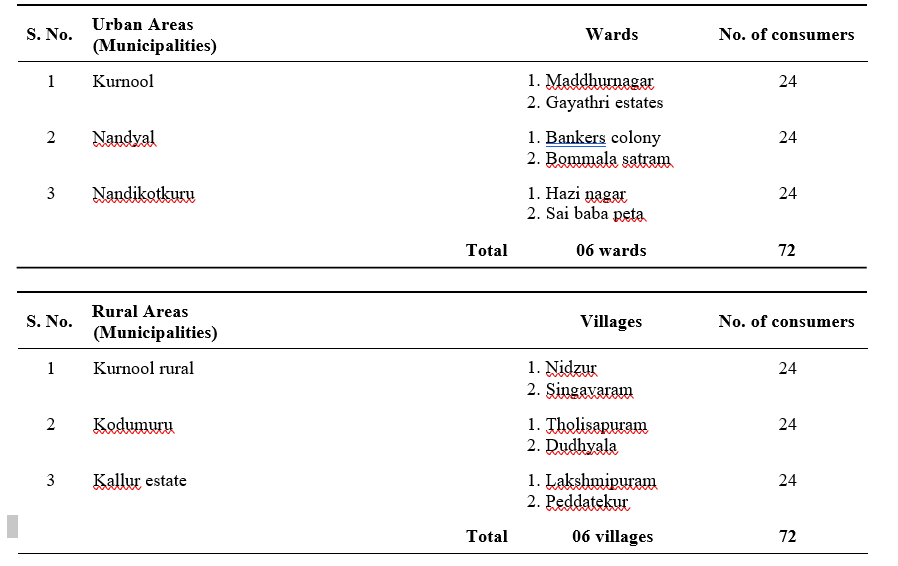Factors Influencing the Consumption Pattern of Millets and Millet Based Products in Kurnool District of Andhra Pradesh
0 Views
M. MEGHANA REDDY*, G. PRASAD BABU, R.P. VASANTHI AND B. RAMANA MURTHY
Institute of Agri-Business Management, S.V. Agricultural College, ANGRAU, Tirupati-517 502.
ABSTRACT
The year 2023 has been declared the International Year of Millets by the United Nations. Millets are small-seeded grains
grown as cereal crops, known for their health-promoting components such as protein, carbohydrates, dietary fibre, vitamins, minerals, antioxidants and phytochemicals. This study aims to understand the consumption patterns of millets and millet- based products in Kurnool district, Andhra Pradesh and identify the factors influencing their consumption. Additionally, it seeks to explore the strategies employed by marketing agencies to promote millets in the region. Two-thirds of percentage of were men (66.67%), while one-third were women (33.33%). Highest education level: Intermediate (29.86%), Secondary education (22.92%), Illiterate (9.72%). Millet consumers with a tradition of millet consumption in the family: 38.89%. Millets was consumed on a daily basis by 48.61%, twice a week by 17.37% and once a week by 15.27%. The preferred time for millet consumption among the high-income group is as follows: Lunch 50% during lunch, 31.25% during breakfast and 18.75% during dinner. Highest consumed millet- Sorghum, followed by Ragi, Korra, and Bajra. Factor influencing millet consumption the most-Health benefits. Health benefits, tradition and medical recommendations significantly influenced millet consumption, while social media played a pivotal role in marketing millet-based products.
KEYWORDS: Millets, Millet based products, consumption.
INTRODUCTION
The year 2023 is declared as international year of millets by UNO. Millets are small-seeded grains which are grown as cereal crops such as sorghum millet (Jowar), proso millet (Varigalu) pearl millet (Bajra) Foxtail Millet (Korra), finger millet (Ragi), browntop millet (andukorra) , barnyard millet (Udalu), little millet (samalu). Millets doesn’t require water unlike any other grains, they can be grown under arid and semi-arid environments.
Various recipes are being prepared in the households and restaurants by using either whole or processed millets in the form of flour/extruded products Most frequently consumed millet recipes are the following
- For breakfast: baked ragi chakli, millet idly, millet Pongal, jowar roti, etc.
- For dinner: Millet curd rice, Jowar medley, Foxtail millet porridge, etc.
The recipes can be interchanged across breakfast and dinner as the per the requirement of the consumer. Over the last few years millet based products are gaining acceptance in India and the number of entrepreneurs consumer preference and the market opportunities for millet and millet-based products.
METHODOLOGY
Three urban areas were selected in Kurnool district based on High income group (HIG) Middle income group (MIG), Low income groups (LIG). From each urban area 2 wards were selected randomly. From each ward 12 respondents were selected based on High income group (HIG) Middle income group (MIG), Low income groups (LIG) (4+4+4) by making total sample size 72. Three rural Mandals were selected in Kurnool district based on HIG, MIG, LIG. From each mandal 2 villages were selected randomly and from each village 12 respondents were selected based on HIG, MIG, LIG (4+4+4) by making total sample size 72.
Garrett’s Ranking Technique
Garrett’s ranking technique was adopted for analysing the factors affecting the consumption pattern of millets and millet-based products. In this method the respondents were asked to rank the factors identified for the purpose of study according to their preferences. Thus, the assigned ranks are calculated by using the following formula
percent position = 
Table 1. Selected areas in Kurnool

Factors affecting the consumption pattern of millets and millet based products

where,
Rij = Rank given for ith variable by the jth individual.
N₁ = Number of variables ranked by the jth individual.
For each calculated per cent position, scores were obtained from corresponding Garrett’s tables.
RESULTS AND DISCUSSIONS
Factors affecting consumption of millets
Health benefits scored the highest Garett score indicated that consumers in the region are motivated by the nutritional advantages associated with millets. The high score suggested that consumers are actively seeking out millets for their positive impact on health.
The second-ranked factor was the tradition of including millets as a part of the local diet. Millets had been a part of traditional diets in Kurnool district for generations and consumers continue to embrace them due to their cultural heritage and familiarity.
The third-ranked factor was the suggestion by doctors. It indicated that medical professionals were recognizing the nutritional value of millets and recommending their inclusion in dietary plans.
The influence of neighbours and friends ranks fourth, suggested that social connections and peer recommendations have a moderate impact on millet consumption. This finding indicated that individuals are influenced by the dietary choices and opinions of those around them.
Taste ranking fifth indicated that while taste is a factor it may not be the primary driver for millet consumption in Kurnool district. Consumers seem to consider taste along with other factors such as health benefits, tradition, and social influence when making their consumption choices.
The availability of Ready to eat (RTE) and Ready to cook (RTC) millet-based foods ranks sixth, suggested that the convenience and accessibility of millet products may be less influential compared to other factors.
Interest towards innovative products ranks last, indicated that consumers in Kurnool district might not be strongly motivated by novel millet-based products or variations. The data suggested that consumers are more inclined towards traditional millet products rather than innovative offerings.
Overall, the study highlighted the importance of health benefits, cultural traditions, and medical recommendations in influencing the consumption pattern of millets in Kurnool district. These findings can inform interventions, marketing strategies, and awareness campaigns aimed at promoting millet consumption based on these influential factors.
LITERATURE CITED
Barratry, D and Rajapushpam, R. 2018. A study on perception of millet products among household consumers in Salem District. IOSR Journal of Business and Management. 20(8): 67-76.
Chitra, D.I and Sulaiman, D. 2017. A study on customer awareness and consumption of minor millets as a diabetic food product–with reference to Madurai city. International Journal of Advanced Scientific Research and Development. 4(1): 38-44.
Kalidas, K and Mahendran, K. 2017. Research paper on buying behaviour of consumers towards instant millet based food products. Food Science Research Journal. 8(2): 196-202.
Dayakar, P.B., Seema. D., Srinivasacharya and Sridevi, N. 2020. Market strategies for promotion of millets: a critical analysis on assessment of market potential of Ready to Eat (RTE) and Ready to Cook (RTC) millet based products in Hyderabad. Asian Journal of Agricultural Extension, Economics and Sociology. 147-155.
- Production Potential of Sweet Corn as Influenced by Organic Manures and Foliar Nutrition
- Characterization of Grain Iron and Zinc Content in Little Millet Genotypes
- Faunistic Studies on Economically Important Lepidopterans in Different Field Crops of Tirupati District
- An Annotated Checklist of Cyperceae, Eriocaulaceae and Potamogetonaceae of Chhattisgarh
- Genetic Divergence Studies for Yield, Yield Components and Resistance to Late Leaf Spot in Groundnut (Arachis Hypogaea L.)
- Effect of Organic Farming on Soil Enzymatic Activity and Productivity of Groundnut Based Cropping System

